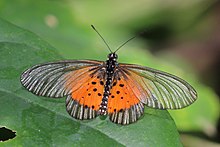Acraea quirina, the common glassy acraea, is a butterfly in the family Nymphalidae. It is found in Senegal, Gambia, Guinea, Sierra Leone, Burkina Faso, Liberia, Ivory Coast, Ghana, Togo, Nigeria, Cameroon, Gabon, the Republic of the Congo, the Central African Republic, Angola, the Democratic Republic of the Congo, Sudan, Uganda, Ethiopia, Kenya, Tanzania and Malawi.[3]
| Common glassy acraea | |
|---|---|

| |
| A. q. quirina, Ghana | |
| Scientific classification | |
| Domain: | Eukaryota |
| Kingdom: | Animalia |
| Phylum: | Arthropoda |
| Class: | Insecta |
| Order: | Lepidoptera |
| Family: | Nymphalidae |
| Genus: | Acraea |
| Species: | A. quirina
|
| Binomial name | |
| Acraea quirina | |
| Synonyms | |
| |
Description
editA. quirina F. (53b). Forewing diaphanous without markings, only in la and at the base of lb scaled with red-yellow or red. Hindwing rose-red to orange-yellow with free basal and discal dots and at the edge of the red-yellow colour often with submarginal dots in all the cellules; marginal band broad and diaphanous. In the female the red-yellow colour is usually replaced by dirty yellow-grey. Sierra Leone to British East Africa. - rosa Eltr. only differs in having the basal part of the forewing above scaled with red or red-yellow rosa. to the apex of the cell and almost to the anal angle. British East Africa. [4]
Subspecies
edit- Acraea quirina quirina (south-eastern Senegal, Gambia, Guinea, Sierra Leone, Burkina Faso, Liberia, Ivory Coast, Ghana, Togo, Nigeria, Cameroon, Gabon, Congo, Central African Republic, Angola, Democratic Republic of the Congo, southern Sudan, Uganda, western Kenya, western Tanzania)
- Acraea quirina rosa Eltringham, 1912 (Ethiopia, northern and eastern Kenya, eastern Tanzania, Malawi)
Biology
editThe habitat consists of forests, extending into the Guinea savanna.
Both sexes mud-puddle during very dry periods.
The larvae feed on Rinorea elliotii, Rinorea subintegrifolia, Rinorea poggei, Rinorea convallariflora and Drypetes species.
Taxonomy
editIt is a member of the Acraea terpsicore species group - but see also Pierre & Bernaud, 2014 [5]
- Acraea (group ranavalona) Henning, 1993, Metamorphosis 4 (1): 11
- Acraea (Acraea) (subgroup quirina) Pierre & Bernaud, 2013, Butterflies of the World 39: 5
References
edit- ^ Fabricius, [J.]C. 1781. Species insectorum, exhibentes eorum differentias specificas, synonyma auctorum, loca natalia, metamorphosin, adjectis observationibus, descriptionibus 2: [ii], 1-499. Hamburgi & Kilonii.
- ^ Acraea at Markku Savela's Lepidoptera and Some Other Life Forms
- ^ "Afrotropical Butterflies: Nymphalidae - Tribe Acraeini". Archived from the original on 2012-08-10. Retrieved 2012-05-31.
- ^ Aurivillius, [P.O.]C. 1908-1924. In: Seitz, A. Die Grosschmetterlinge der Erde Band 13: Abt. 2, Die exotischen Grosschmetterlinge, Die afrikanischen Tagfalter, 1925, 613 Seiten, 80 Tafeln (The Macrolepidoptera of the World 13).Alfred Kernen Verlag, Stuttgart. This article incorporates text from this source, which is in the public domain.
- ^ Pierre & Bernau, 2014 Classification et Liste Synonymique des Taxons du Genre Acraea pdf
External links
edit- Images representing Acraea quirina at Bold.
- Acraea quirina quirina Archived 2020-01-27 at the Wayback Machine at Pteron